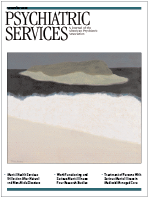Psychiatrists' Acceptance of Medicaid Patients
To the Editor: In the April issue, Wilk and colleagues (1) raised concerns about Medicaid patients' access to psychiatrists and the low rate of acceptance of Medicaid patients by psychiatrists, a concern that has been raised by others (2). We examined the relationship between Medicaid reimbursement rates and psychiatrists' self-reported acceptance of Medicaid patients and found that low Medicaid reimbursement rates were associated with low participation by psychiatrists for service code 90807 (individual psychotherapy with medical evaluation for 45 minutes).
On the basis of the assumption that psychiatrists' sensitivity to reimbursement rates might occur in the lower range of rates, we divided Medicaid reimbursement rates by a median split. We found a positive correlation (r=.52, p=.03) between rates for service code 90807 (median split=$64.10) and psychiatrists' self-reported acceptance of Medicaid patients for the lower half of the range of the reimbursement rate but not the upper half. We found no such relationship for codes 90801 (diagnostic interview exam) and 90862 (pharmacologic management), nor did we find simple, significant correlations between these three codes and the full distribution of reimbursement rates (r=-.03, .25, and .20, respectively). Details of multivariate analyses of variables that affect acceptance of Medicaid patients by psychiatrists are described elsewhere (1).
As in the study by Wilk and colleagues, we used data from an item in the 2002 National Survey of Psychiatric Practice, which was conducted by the American Psychiatric Institute for Research and Education (3). A total of 1,189 psychiatrists responded to an item about acceptance of patients by payer. Because we were unable to find Medicaid reimbursement data for 2002, we used 2001 reimbursement rates by state for codes 90801, 90807, and 90862 from an American Academy of Pediatrics data set published on its Web site. There was substantial distribution in values for both psychiatrist acceptance rates and Medicaid reimbursement rates for code 90807.
Our preliminary, suggestive observation warrants further study with better designs and more complex models. The period between 2001 and 2002 was one of significant change for Medicaid. States faced budget deficits and cut eligibility, benefits, and reimbursement. Therefore, the discrepancy in time between the 2001 reimbursement rates and the 2002 data on psychiatrists' acceptance of Medicaid patients is a weakness of these analyses. Also, many factors affect psychiatrists' decisions to accept Medicaid patients, including administrative burden and cross-cultural preferences, among others, and these factors were not included in the analyses.
Another important consideration is the possibility of a more pronounced association between reimbursement levels and the volume of new Medicaid patients that psychiatrists can accept, whereas our analyses examined the association between accepting "any" new Medicaid patients and reimbursement. Furthermore, the relationship between reimbursement rates and acceptance may be reciprocal and complex and not simply positive—for example, when a low rate of psychiatrist participation spurs higher state Medicaid reimbursement rates. Such inverse correlations would be investigated best on a state-by-state basis, which was not possible with our data.
The observation made in this letter is potentially important for child psychiatrists, clinic psychiatrists, international medical graduates, and early-career psychiatrists, who have caseloads with large proportions of patients whose care is covered by Medicaid (4).
Dr. Jacobs is with the department of psychiatry at Yale University in New Haven, Connecticut. Dr. Wilk and Dr. Rubio-Stipec are with the American Psychiatric Institute for Research and Education of the American Psychiatric Association in Arlington, Virginia.
1. Wilk JE, West JC, Narrow WE, et al: Access to psychiatrists in the public sector and in managed care plans. Psychiatric Services 56:408–410,2005Link, Google Scholar
2. Perloff JD, Kletke P, Fossett JW: Which physicians limit their Medicaid participation and why. Chicago, American Hospital Association. Available at www.aha.org/hsr/databaseGoogle Scholar
3. Scully JA, Wilk JE: Selected characteristics and data of psychiatrists in the United States, 2001–2002. Academic Psychiatrist 27:247–251,2003Crossref, Medline, Google Scholar
4. Jacobs SC, Wilk JE, Chen D, et al: Medicaid as a payer for services provided by psychiatrists. Psychiatric Services 56:1356,2005Link, Google Scholar



